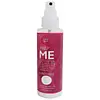What's inside
What's inside
 Benefits
Benefits

 Concerns
Concerns

 Ingredients Side-by-side
Ingredients Side-by-side

Water
Skin ConditioningCetearyl Alcohol
EmollientBehentrimonium Chloride
PreservativeCyclopentasiloxane
EmollientParfum
MaskingBenzyl Alcohol
PerfumingCyclohexasiloxane
EmollientAmodimethicone
Ethylhexyl Methoxycinnamate
UV AbsorberDimethiconol
EmollientCeteareth-20
CleansingCetrimonium Chloride
AntimicrobialSelaginella Lepidophylla Extract
EmollientDehydroacetic Acid
PreservativeC11-15 Pareth-5
EmulsifyingC11-15 Pareth-9
EmulsifyingHydrolyzed Silk
HumectantAcetic Acid
BufferingPhenoxyethanol
PreservativeDecylene Glycol
Skin ConditioningCaprylyl Glycol
EmollientLinalool
PerfumingLimonene
PerfumingHexyl Cinnamal
PerfumingCitronellol
PerfumingLactobacillus Ferment
Skin ConditioningAlpha-Isomethyl Ionone
PerfumingGeraniol
PerfumingPotassium Sorbate
PreservativeSodium Benzoate
MaskingWater, Cetearyl Alcohol, Behentrimonium Chloride, Cyclopentasiloxane, Parfum, Benzyl Alcohol, Cyclohexasiloxane, Amodimethicone, Ethylhexyl Methoxycinnamate, Dimethiconol, Ceteareth-20, Cetrimonium Chloride, Selaginella Lepidophylla Extract, Dehydroacetic Acid, C11-15 Pareth-5, C11-15 Pareth-9, Hydrolyzed Silk, Acetic Acid, Phenoxyethanol, Decylene Glycol, Caprylyl Glycol, Linalool, Limonene, Hexyl Cinnamal, Citronellol, Lactobacillus Ferment, Alpha-Isomethyl Ionone, Geraniol, Potassium Sorbate, Sodium Benzoate
Water
Skin ConditioningDimethicone
EmollientCetearyl Alcohol
EmollientParfum
MaskingArgania Spinosa Kernel Oil
EmollientBehentrimonium Chloride
PreservativePhenoxyethanol
PreservativeGlyceryl Stearate Se
EmulsifyingCaprylyl Glycol
EmollientIsopropyl Alcohol
SolventChlorphenesin
AntimicrobialCitric Acid
BufferingCI 15985
Cosmetic ColorantEugenol
PerfumingButylphenyl Methylpropional
PerfumingHydroxyisohexyl 3-Cyclohexene Carboxaldehyde
MaskingLinalool
PerfumingAlpha-Isomethyl Ionone
PerfumingWater, Dimethicone, Cetearyl Alcohol, Parfum, Argania Spinosa Kernel Oil, Behentrimonium Chloride, Phenoxyethanol, Glyceryl Stearate Se, Caprylyl Glycol, Isopropyl Alcohol, Chlorphenesin, Citric Acid, CI 15985, Eugenol, Butylphenyl Methylpropional, Hydroxyisohexyl 3-Cyclohexene Carboxaldehyde, Linalool, Alpha-Isomethyl Ionone
Ingredients Explained
These ingredients are found in both products.
Ingredients higher up in an ingredient list are typically present in a larger amount.
Alpha-Isomethyl Ionone is a fragrance. It can be synthetically created or naturally occurring.
The scent of Alpha-Isomethyl Ionone is described as "flowery" but can also be "woody".
Naturally occurring Alpha-Isomethyl Ionone may be found in Saccharomyces cerevisiae, or the yeast used to make wine and bread.
The term 'fragrance' is not regulated in many countries. In many cases, it is up to the brand to define this term. For instance, many brands choose to label themselves as "fragrance-free" because they are not using synthetic fragrances. However, their products may still contain ingredients such as essential oils that are considered a fragrance.
Learn more about Alpha-Isomethyl IononeThis ingredient is a preservative and often used for it's anti-static properties. You'll most likely see this ingredient in hair conditioners.
It does not cause irritation or sensitization in leave-on products at 1-5%.
Caprylyl Glycol is a humectant and emollient, meaning it attracts and preserves moisture.
It is a common ingredient in many products, especially those designed to hydrate skin. The primary benefits are retaining moisture, skin softening, and promoting a healthy skin barrier.
Though Caprylyl Glycol is an alcohol derived from fatty acids, it is not the kind that can dry out skin.
This ingredient is also used as a preservative to extend the life of products. It has slight antimicrobial properties.
Learn more about Caprylyl GlycolCetearyl alcohol is a mixture of two fatty alcohols: cetyl alcohol and stearyl alcohol. It is mainly used as an emulsifier. Emulsifiers help prevent the separation of oils and products. Due to its composition, it can also be used to thicken a product or help create foam.
Cetearyl alcohol is an emollient. Emollients help soothe and hydrate the skin by trapping moisture.
Studies show Cetearyl alcohol is non-toxic and non-irritating. The FDA allows products labeled "alcohol-free" to have fatty alcohols.
This ingredient is usually derived from plant oils such as palm, vegetable, or coconut oils. There is debate on whether this ingredient will cause acne.
Due to the fatty acid base, this ingredient may not be Malassezia folliculitis safe.
Learn more about Cetearyl AlcoholLinalool is a fragrance and helps add scent to products. It's derived from common plants such as cinnamon, mint, citrus, and lavender.
Like Limonene, this ingredient oxidizes when exposed to air. Oxidized linalool can cause allergies and skin sensitivity.
This ingredient has a scent that is floral, spicy tropical, and citrus-like.
Learn more about LinaloolParfum is a catch-all term for an ingredient or more that is used to give a scent to products.
Also called "fragrance", this ingredient can be a blend of hundreds of chemicals or plant oils. This means every product with "fragrance" or "parfum" in the ingredients list is a different mixture.
For instance, Habanolide is a proprietary trade name for a specific aroma chemical. When used as a fragrance ingredient in cosmetics, most aroma chemicals fall under the broad labeling category of “FRAGRANCE” or “PARFUM” according to EU and US regulations.
The term 'parfum' or 'fragrance' is not regulated in many countries. In many cases, it is up to the brand to define this term.
For instance, many brands choose to label themselves as "fragrance-free" because they are not using synthetic fragrances. However, their products may still contain ingredients such as essential oils that are considered a fragrance by INCI standards.
One example is Calendula flower extract. Calendula is an essential oil that still imparts a scent or 'fragrance'.
Depending on the blend, the ingredients in the mixture can cause allergies and sensitivities on the skin. Some ingredients that are known EU allergens include linalool and citronellol.
Parfum can also be used to mask or cover an unpleasant scent.
The bottom line is: not all fragrances/parfum/ingredients are created equally. If you are worried about fragrances, we recommend taking a closer look at an ingredient. And of course, we always recommend speaking with a professional.
Learn more about ParfumPhenoxyethanol is a preservative that has germicide, antimicrobial, and aromatic properties. Studies show that phenoxyethanol can prevent microbial growth. By itself, it has a scent that is similar to that of a rose.
It's often used in formulations along with Caprylyl Glycol to preserve the shelf life of products.
Water. It's the most common cosmetic ingredient of all. You'll usually see it at the top of ingredient lists, meaning that it makes up the largest part of the product.
So why is it so popular? Water most often acts as a solvent - this means that it helps dissolve other ingredients into the formulation.
You'll also recognize water as that liquid we all need to stay alive. If you see this, drink a glass of water. Stay hydrated!
Learn more about Water